Some teachers make too many of copies of papers. To make a copy, they can start with as few as one piece of paper and make more papers just like that piece of paper. All of these copies are almost always the same as the first paper. All the words, lines, and pictures look exactly the same. We could almost say that the paper is asexually reproducing. One paper is turning into more papers that are exactly the same as the first. That's how some plants and other organisms reproduce too.
Strawberry plants slowly grow out a branch, part of the plant called a runner. This runner will grow out like a long finger for a little while. Soon it will grow roots and leaves in one spot, and keep growing away from the plant to make more. Each different place where the strawberry plant's roots go into the ground will grow into a different plant. Each different plant from the runners has the exact same genes as the first one. You could cut the runners, and it would not hurt the plants because they are all separate organisms. Strawberry plants can grow very quickly by making copies.
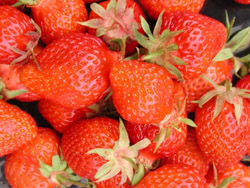
Strawberries. Yummmmmmmmmmmm.
Life is not as simple as making copies of a paper. Organisms reproduce with genes. In order to make you, your parents' bodies made copies of their genes. One half of your mother's genes was copied into an egg, and one half of your father's genes was copied into a sperm. Those two things got together and made you! You get half of your genes from each of your parents. We can also say you inherited half of your genes from your mother and half from your father. To
inherit genes means to have them passed down to you from a parent.
When something reproduces asexually, it makes another organism with a copy of its genes. There is no egg and no sperm. The organism just makes a copy of its own genes. This can grow into another plant or single cell with exactly the same genes as its one parent. Every new strawberry plant from the runner inherits all the genes of the plant the runner grew from.
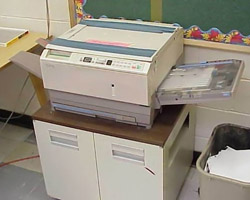
We're pretty sure this copier had nothing to do with making you...
Joseph Barillari at en.wikipedia., CC BY-SA 3.0 , via Wikimedia Commons
Copy machines almost always work the way you want them to. Your teacher might make copies of the work that you and your class have to do that day. The teacher might want you to read something, or answer a few questions, and everything is fine. But then"¦ sometimes"¦ something goes very, VERY WRONG. One of the sets of copies is missing a page, or there is a crazy black mark on one of the pages. While it's mean to call papers names, but you could say that the crazy paper is a mutant. This same thing can happen when genes are being copied. When genes are copied wrong, it's called a
mutation.

Moles can come from mutations in skin cells.
National Institutes of Health, National Cancer Institute
You have 25,000 copies of your parents' genes That's a lot of copies! Sometimes a copy can come out wrong. Remember that genes are like instructions for your body. A small change or mutation to them will not do anything bad most of the time. People can have mutations and not even know it. The change could be like an extra letter in a word. The letter does not make a big difference because you still can figure out what the word and sentence mean. Even with a mistake like this in your genes, your body still knows what to do and things turn out normal.
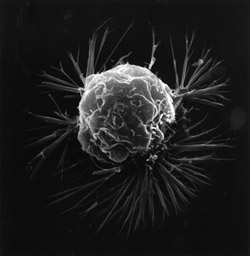
This is a picture of breast cancer. Cancer comes from bad mutations in genes.
National Cancer Institute, Bruce Wetzel and Harry Schaefer
There are some mutations that can actually change the instructions for the way an organism is built. This change could be like deleting a sentence in the instructions, or adding an extra step that wasn't needed. To show this, scientists studied flies and found that most of these mutations that make a change are bad and will hurt the fly. Some of the mutations will not change the fly, and some can even be good.
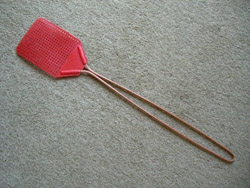
A fly's worst nightmare.
Wikimedia, Edward Betts
Here are a couple things that could happen if a fly had a mutation in the gene that gives instructions for its wings:
1. It's most likely that the mutation will be bad. It might make the wings not work well. It will be hard for the fly to find food or another fly to have baby flies with.
2. A mutation might make its wings a different shape, but they still work the same. This doesn't make the fly better or worse.
3. A good mutation might change the fly's wings so it can fly a little bit faster. Flying faster would make it easy to find food or another fly to have baby flies with.
There are many ways that mutations could help. What if you are an insect that only eats bananas and every banana tree where you live dies? What if every organism like you starts getting so sick that they die? Having nothing to eat or being in a place where a sickness kills all your friends would mean you would probably die too. It's not all bad, because some flies might have mutations that can help protect them from the sickness, or let them eat foods they did not eat before. When there is variation between organisms, they can have a better chance of staying alive. Being a mutant is not the only way you can be different. Sexual reproduction also makes organisms different. When you were born, you inherited half of your father's genes and half of your mother's genes. You are only half of each of them and you are different from any person that has ever lived.
Being different can also help a bird, a single cell, or anything living, stay alive. When organisms have different genes, it is called
genetic variation. Genetic variation can mean that you and your family all have different genes, or that you and your pets have different genes. Genetic variation is very important because organisms that have differences between them have a better chance of surviving than ones who are all the same. If something really bad happens to a group of organisms, differences can help some of them to stay alive!
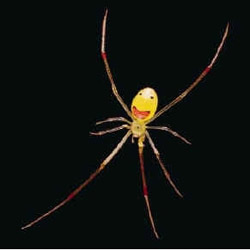
The happy face spider! Yes it's a real spider! The genetic variation between these spiders gives some of them happy faces on their backs.